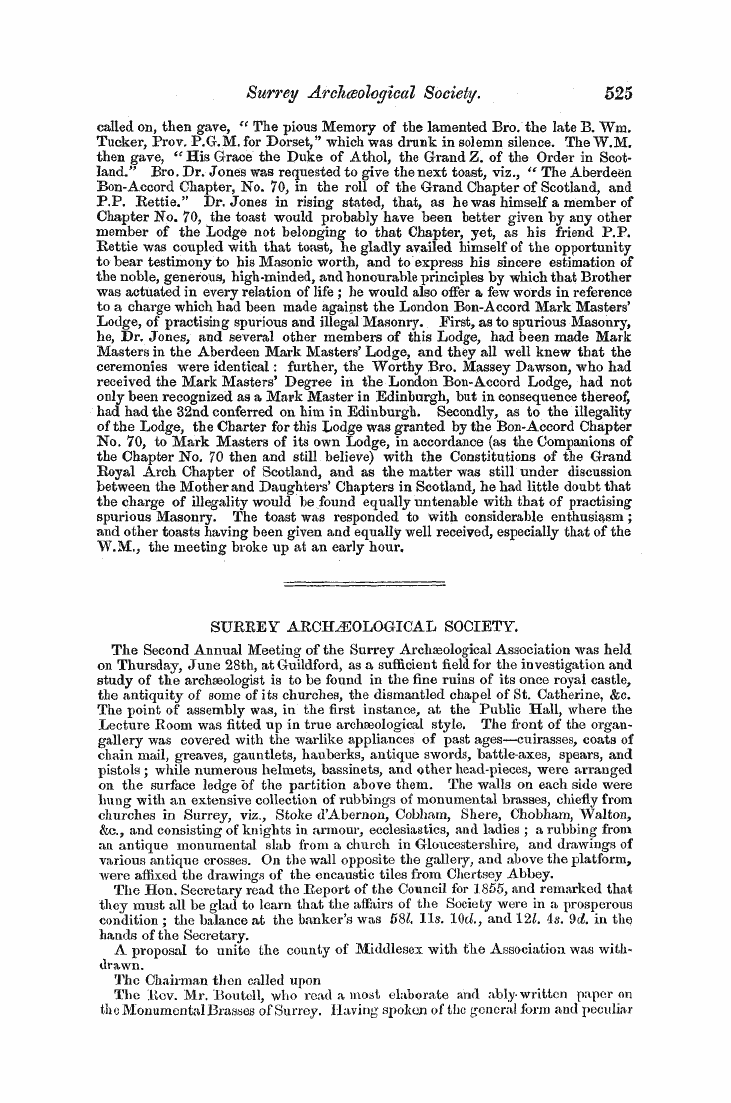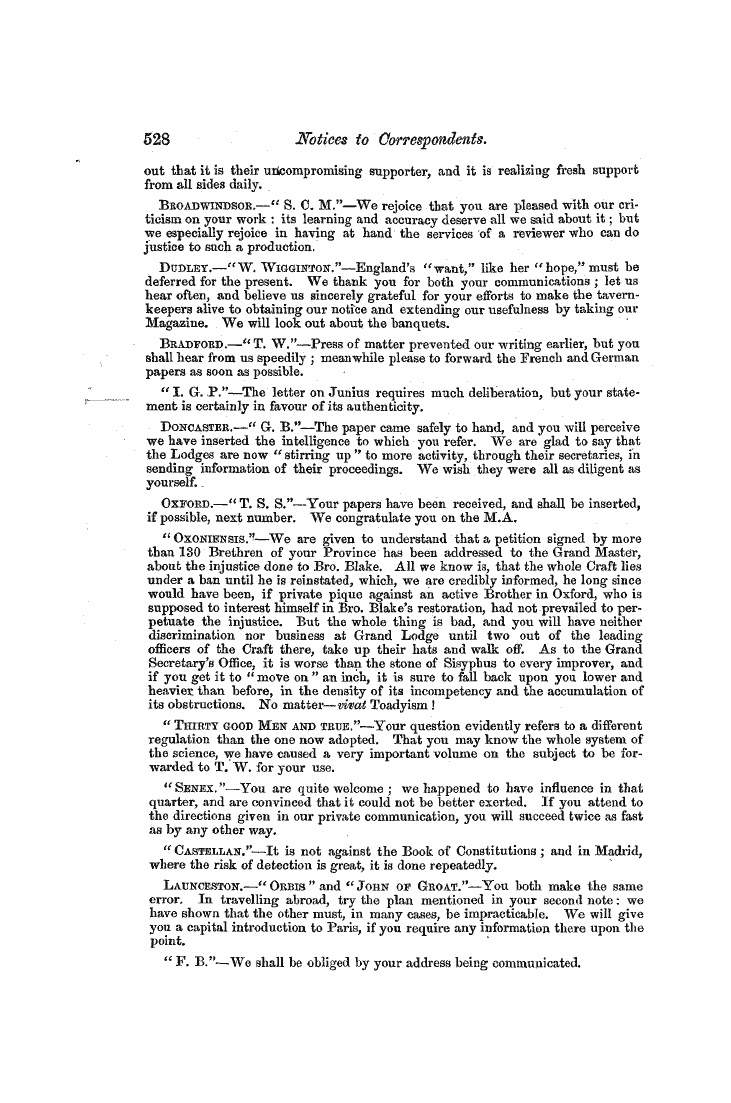-
Articles/Ads
Article Untitled Article ← Page 6 of 7 →
Note: This text has been automatically extracted via Optical Character Recognition (OCR) software.
Untitled Article
the body maintains about the same temperature in summer as in winter . Local heat and cold are equally provided for . Excessive heat or extreme cold blister the surface . A blister is a bag of water interposed between the enemy and the living skin , to preserve its life . In every animal , plant , egg , and seed , life is tenacious of temperature . Take two newly laid eggs ; pass through one of them a galvanic shock ; place them both for half an hour in a freezing
mixture of snow and salt . The galvanized egg , which has been killed by the shock , will be found frozen ; the other will be unchanged ; its living principle has enabled it to retain its temperature ! The same is true of seeds , which will retain their living principle and temperature for ages . Thus , life not only takes care of itself , but provides for future beings .
4 . Living beings feel and move . Minerals have no feeling , and never move spontaneously . In all animals and vegetables motion is the result of feeling . Vegetables feel , or they would not move . This may not be what we call conscious feeling ; but it is feeling in the physiological sense of that term—the power of receiving impressions
which rouse to vital action—excitability . After death this ceases , and with it the power of moving ; a dead flower will no longer open its petals to the genial sun , nor close them on the approach of the evening damps . Generally speaking , animals alone , and not vegetables , have the power of locomotion ; but more of this hereafter .
r 5 . Minerals exist independently of the organized world , in a sort of cold abstraction ; whereas animals and vegetables cannot exist except in mutual dependence upon each other . Divine wisdom has established an arrangement by which they are wonderfully adapted to support each other ' s kingdom . There is a sort of vital commerce ,
by which their mutual advantage is secured , and without which neither could long exist . There are different marts in which this commerce is carried on . The air , the earth , and the sea are successively the scene of exchange , and these are at all times respectively subsidiary to its operations . The atmosphere is fitted for the respiration of animals by the emanation of oxygen gas constantly given off by the leaves of living vegetables ; and these latter inhale by their leaves
the carbonic acid gas given out by respiration from the lungs of animals . The earth ' s surface is also tributary to the mutual support of animals and vegetables , by a similar arrangement . Living vegetables supply animals with food , and the decomposition of animal matter fits the soil for the supply of nourishment to vegetables . The same process , with some variation , is going forward in the depths of the ocean , and in the beds of rivers .
6 . A disposition to a curvilinear form , or rotundity of figure , is a remarkable feature of all organized beings , both animal and vegetable . Minerals are generally sharp and pointed , composed of right lines and rectilinear angles , unless external causes shall have rounded them . The natural form of the various rocks , salts , bitumens , and metals with which the mineral world abounds , is that of the acuminated crystal , or the horizontal layer . The rounded flint stones on
Note: This text has been automatically extracted via Optical Character Recognition (OCR) software.
Untitled Article
the body maintains about the same temperature in summer as in winter . Local heat and cold are equally provided for . Excessive heat or extreme cold blister the surface . A blister is a bag of water interposed between the enemy and the living skin , to preserve its life . In every animal , plant , egg , and seed , life is tenacious of temperature . Take two newly laid eggs ; pass through one of them a galvanic shock ; place them both for half an hour in a freezing
mixture of snow and salt . The galvanized egg , which has been killed by the shock , will be found frozen ; the other will be unchanged ; its living principle has enabled it to retain its temperature ! The same is true of seeds , which will retain their living principle and temperature for ages . Thus , life not only takes care of itself , but provides for future beings .
4 . Living beings feel and move . Minerals have no feeling , and never move spontaneously . In all animals and vegetables motion is the result of feeling . Vegetables feel , or they would not move . This may not be what we call conscious feeling ; but it is feeling in the physiological sense of that term—the power of receiving impressions
which rouse to vital action—excitability . After death this ceases , and with it the power of moving ; a dead flower will no longer open its petals to the genial sun , nor close them on the approach of the evening damps . Generally speaking , animals alone , and not vegetables , have the power of locomotion ; but more of this hereafter .
r 5 . Minerals exist independently of the organized world , in a sort of cold abstraction ; whereas animals and vegetables cannot exist except in mutual dependence upon each other . Divine wisdom has established an arrangement by which they are wonderfully adapted to support each other ' s kingdom . There is a sort of vital commerce ,
by which their mutual advantage is secured , and without which neither could long exist . There are different marts in which this commerce is carried on . The air , the earth , and the sea are successively the scene of exchange , and these are at all times respectively subsidiary to its operations . The atmosphere is fitted for the respiration of animals by the emanation of oxygen gas constantly given off by the leaves of living vegetables ; and these latter inhale by their leaves
the carbonic acid gas given out by respiration from the lungs of animals . The earth ' s surface is also tributary to the mutual support of animals and vegetables , by a similar arrangement . Living vegetables supply animals with food , and the decomposition of animal matter fits the soil for the supply of nourishment to vegetables . The same process , with some variation , is going forward in the depths of the ocean , and in the beds of rivers .
6 . A disposition to a curvilinear form , or rotundity of figure , is a remarkable feature of all organized beings , both animal and vegetable . Minerals are generally sharp and pointed , composed of right lines and rectilinear angles , unless external causes shall have rounded them . The natural form of the various rocks , salts , bitumens , and metals with which the mineral world abounds , is that of the acuminated crystal , or the horizontal layer . The rounded flint stones on































































